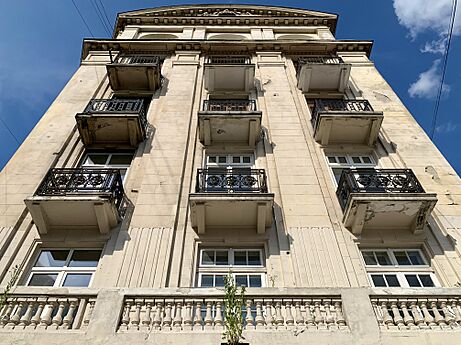Rosette (design) facts for kids

A rosette is a beautiful, round design that looks like a flower. It's not a real flower, but an artistic way of drawing or carving one. Think of it as a flower that has been simplified and made into a pattern.
Contents
Where Rosettes Come From
The idea for the rosette design comes from nature. It's inspired by a plant's "botanical rosette." This is when a plant's leaves grow in a circle, spreading out from the stem. You can often see this shape even after the plant's flowers have gone away.
History of Rosette Designs
People have used rosette designs for a very long time. They appear on carved objects from ancient times. You can find them in Mesopotamia, which was a very old civilization. They were also used to decorate stone slabs called steles in Ancient Greece.
The rosette was an important symbol for the goddess Ishtar. This symbol originally belonged to another goddess named Inanna. Later, the rosette design became popular in Romanesque and Renaissance buildings. It was also common in art from Central Asia. From there, it spread all the way to India. In India, it was used as a decoration in Greco-Buddhist art, which mixed Greek and Buddhist styles.
Ancient Rosette Art
One of the first times we see the rosette in ancient art is in Egypt. This was around 4,000 years BC. Another early place in the Mediterranean region where rosettes appeared was on the island of Crete. The design can be seen on the Phaistos Disc, which was found at an old archaeological site called Phaistos.
-
An Ancient Greek stone slab (stele) with three rosettes at the top. It's from around 150 BC and is made of marble. You can see it at the Louvre museum.
-
Rosettes at the bottom of a statue of the Buddha. This statue is from Gandhara, a region that blended Greek and Buddhist art. It's from the 1st or 2nd century AD and is made of stone. It's in the Tokyo National Museum.
How Rosettes Are Used Today
Today, this flower pattern is still very popular. Artists often carve it into stone or wood. These carvings become beautiful decorations for buildings and furniture. Rosettes are also used in metalworking and jewelry. They can form a decorative edge or mark where two different materials meet.
Rosette decorations are also used for official military awards. You might see them on modern clothes too. People often wear rosettes at political or sporting events to show support. Sometimes, rosettes even decorate musical instruments, like around the sound holes of guitars.
Gallery
-
Minoan rosettes on a Kamares bowl. It's from 1850-1700 BC and made of ceramic. It's at the Archaeological Museum of Heraklion, Greece.
-
Ancient Egyptian rosettes on a ceiling painting. It's from the palace of Amenhotep III, around 1390–1353 BC. It's at the Metropolitan Museum of Art, New York City.
-
Ancient Egyptian rosettes on the wooden chest of Tutankhamun. It's from 1336-1327 BC and has ivory details. It's at the Egyptian Museum in Cairo.
-
Assyrian rosettes on an ivory piece from Nimrud. It's from the 9th to 7th century BC and is at the Iraq Museum in Baghdad.
-
Babylonian glazed brick pieces with rosette decoration. They are from 539-330 BC and are at the Vorderasiatisches Museum Berlin.
-
Persian Achaemenid rosette patterns on a wall. It's from around 490 BC and made of limestone. You can see it at Persepolis in Iran.
-
Roman rosettes in the ceiling of the Arch of Septimius Severus in Rome. It was built in 203 AD.
-
Romanesque rosettes on the top parts of columns (capitals) from the Vézelay Abbey in France. They were made between 1120-1150.
-
A Tudor rose (a type of rosette) added to the bottom of the Gothic Royal Gold Cup. This was done during the time of Henry VIII. The cup is from the late 14th century and is at the British Museum.
-
Baroque rosettes on a carpet made by the Savonnerie manufactory. It's from 1668–1685 and is at the Metropolitan Museum of Art.
-
Rosettes in a print from the 17th or 18th centuries. It's at the Cooper Hewitt, Smithsonian Design Museum in New York City.
-
Neoclassical rosettes on the Arc de Triomphe du Carrousel in Paris. It was designed by Charles Percier and Pierre-François-Léonard Fontaine and built from 1806-1808.
-
Neoclassical rosettes on the arms of an armchair. It was made by Jacob Desmalter in 1808 and is at the Louvre.
-
A Neoclassical rosette on a door handle of the University Building in Bucharest, Romania. It was likely designed by Nicolae Ghica-Budești and built from 1914-1934.
-
Art Deco rosettes on a building in Bucharest. They are from around 1930.
See also
- Six petal rosette






































